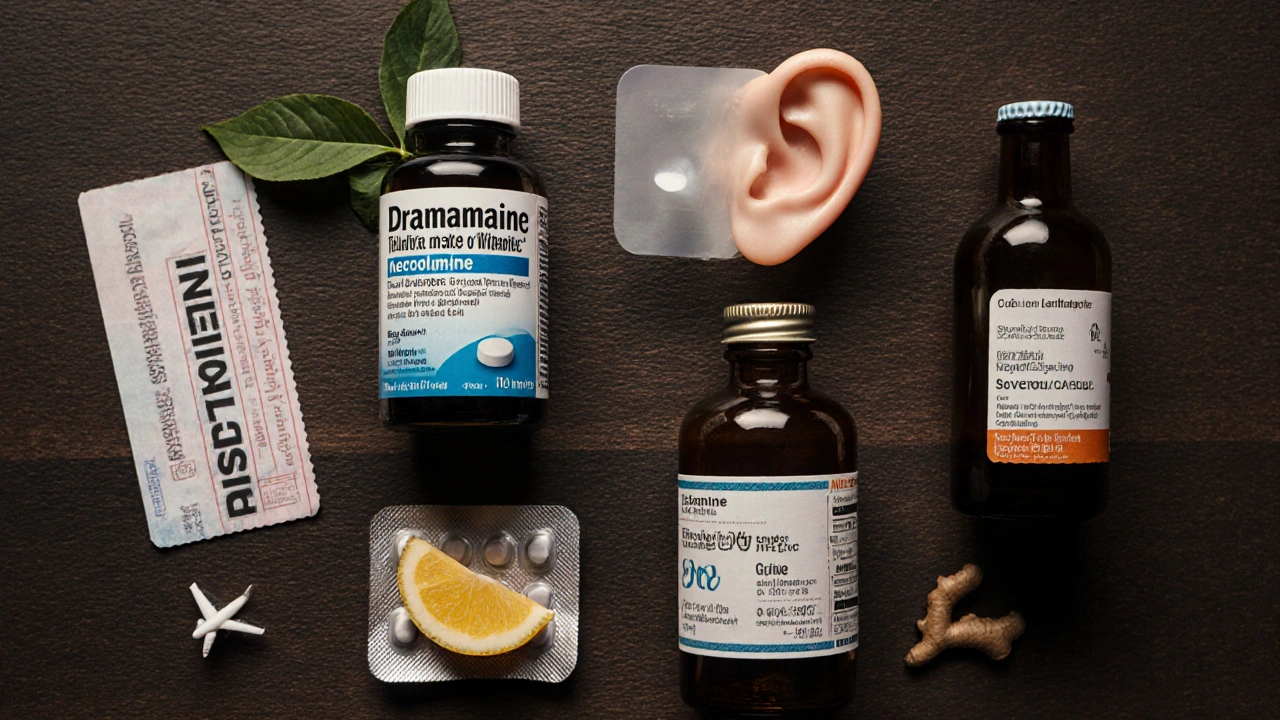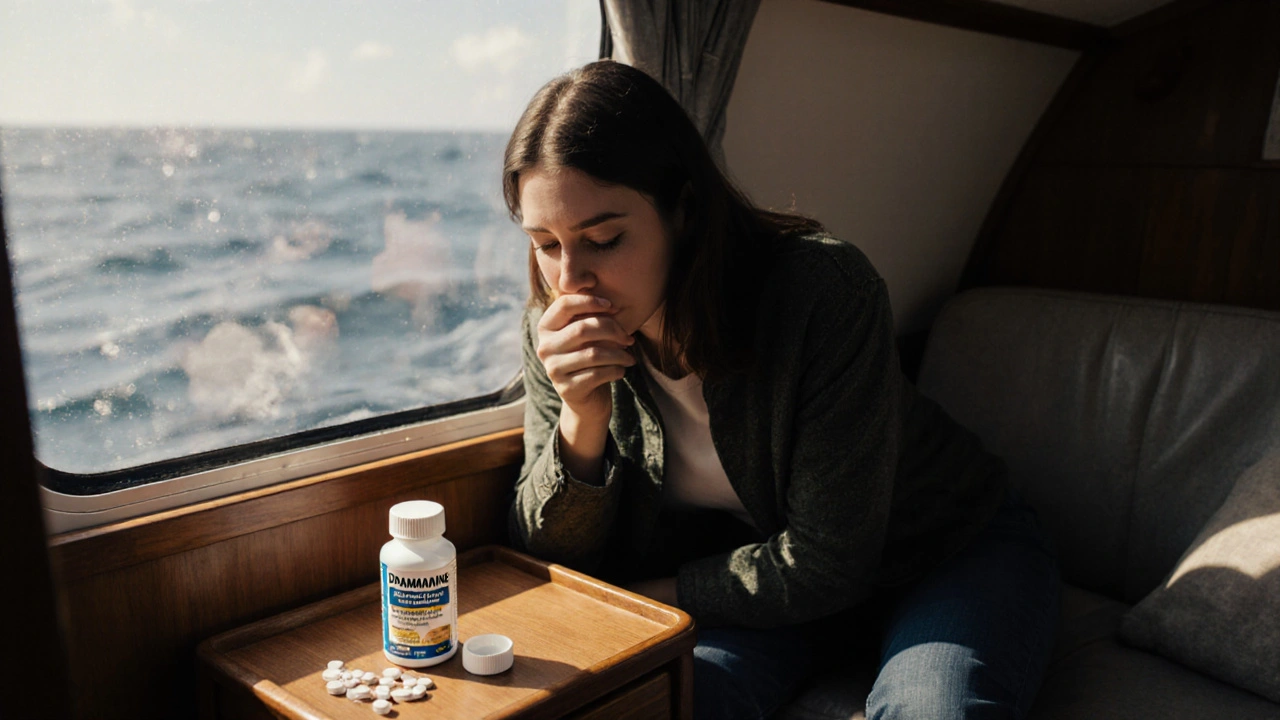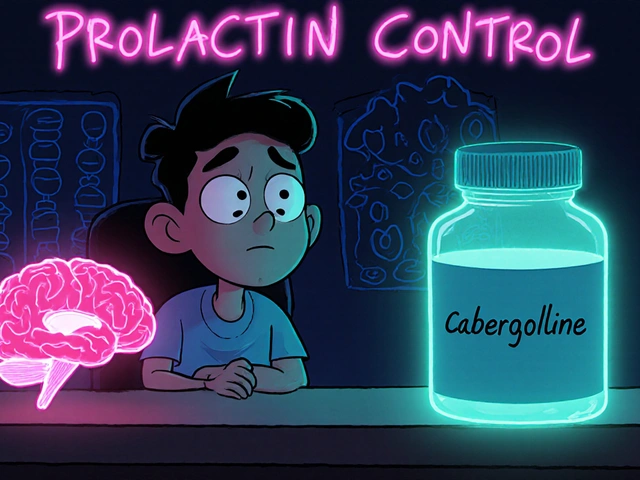Motion Sickness Remedy Selector
Find Your Best Motion Sickness Remedy
Answer a few quick questions to get personalized recommendations for the most effective motion sickness remedy for your specific situation.
If you’ve ever felt the world spin on a boat, plane, or winding road, you know how miserable motion sickness can be. The market is flooded with pills, patches, and even natural remedies, but which one actually eases your nausea without turning you into a sleepy zombie? This Dramamine comparison breaks down the most common options, shows where each one shines, and helps you pick the right remedy for your next journey.
Key Takeaways
- Dramamine (dimenhydrinate) works fast and is good for short trips, but it often causes drowsiness.
- Meclizine offers longer relief with less sedation, making it ideal for multi‑day travel.
- Scopolamine patches provide continuous protection for up to 72hours, perfect for cruises.
- Ginger and VitaminB6 are safe natural choices, though they may be less potent for severe symptoms.
- Prescription options like promethazine are strongest but come with stricter side‑effect profiles.
How to Choose a Motion‑Sickness Remedy
Before diving into product specifics, think about three practical factors that most travelers overlook:
- Travel duration: A short car ride needs a quick‑acting tablet; a week‑long cruise may justify a patch.
- Side‑effect tolerance: Some people can handle a bit of drowsiness; others need to stay alert.
- Medication restrictions: Prescription drugs need a doctor’s note; natural supplements are generally unrestricted.
Keep these criteria in mind as you compare each option below.

Primary Options Compared
Below is a quick glance at the leading remedies.
| Product | Active Ingredient | Form | Typical Dose | Onset | Duration | Common Side Effects | Prescription? |
|---|---|---|---|---|---|---|---|
| Dramamine (Dimenhydrinate) | Dimenhydrinate | Oral tablet, chewable | 50mg every 4‑6h (max 400mg/24h) | 15‑30min | 4‑6h | Drowsiness, dry mouth, blurred vision | No |
| Meclizine (Bonine) | Meclizine hydrochloride | Oral tablet, chewable | 25‑50mg 1h before travel | 30‑60min | 24h | Mild drowsiness, headache | No |
| Scopolamine (Transdermal Patch) | Scopolamine hydrobromide | Skin patch (12cm²) | One patch placed behind ear 4h before travel | 1‑2h | Up to 72h | Drowsiness, dry mouth, blurred vision, skin irritation | No (OTC in many countries) |
| Diphenhydramine (Benadryl) | Diphenhydramine HCl | Oral tablet, liquid | 25‑50mg 30min before travel | 15‑30min | 4‑6h | Heavy sedation, dry mouth, urinary retention | No |
| Ginger (Zingiber officinale) | Ginger root extract | Capsules, chewable tablets, tea | 250mg 30min before travel (or ~1g fresh ginger) | 30‑60min | 4‑6h | Heartburn, mild stomach upset | No |
| VitaminB6 (Pyridoxine) | Pyridoxine hydrochloride | Oral tablet | 25‑50mg 30min before travel | 45‑60min | 4‑6h | Rarely any; high doses may cause nerve issues | No |
| Promethazine (Phenergan) | Promethazine hydrochloride | Oral tablet, rectal suppository | 12.5‑25mg 30min before travel | 30‑60min | 6‑8h | Strong sedation, low blood pressure, dry mouth | Yes |
Deep Dive into Each Option
1. Dramamine (Dimenhydrinate)
Dramamine is an antihistamine that blocks the signals that make you feel nauseous. It’s been on shelves since the 1940s, so you’ll find it in almost any pharmacy. The drug starts working in about 15‑30minutes, which is fast enough for car trips or short flights. The trade‑off? Up to 70% of users report noticeable drowsiness, especially at higher doses.
Typical side effects include dry mouth, blurred vision, and a mild “head‑in‑the‑clouds” feeling. If you need to stay alert-driving, operating machinery, or caring for kids-Dramamine might not be the best pick.
2. Meclizine (Bonine)
Meclizine belongs to the same antihistamine family but crosses the blood‑brain barrier a bit less, which translates to milder sedation. One 25‑mg tablet taken an hour before departure can protect you for a full day, making it the go‑to for road trips that span many hours.
Because it lasts longer, you’ll often need only a single dose instead of re‑dosing every few hours. Side effects are usually limited to mild headache or light drowsiness. It’s also marketed as “Less Drowsy” on many packaging lines.
3. Scopolamine Patch
Scopolamine is a classic in motion‑sickness treatment, but the patch format is what sets it apart. You stick a small patch behind the ear a few hours before travel; the medication then slowly releases into your bloodstream for up to three days.
This is perfect for cruises, long-haul flights, or multi‑day bus tours where you don’t want to keep popping pills. However, the patch can cause skin irritation and the side‑effect profile-dry mouth, blurred vision, and occasional confusion-mirrors the oral antihistamines.
4. Diphenhydramine (Benadryl)
Benadryl is another first‑generation antihistamine, widely recognized for its strong sleep‑inducing properties. It works fast (15‑30minutes) and is inexpensive, but the sedation is often “knock‑out” level, which many travelers find unacceptable unless they’re planning to rest.
Because it’s an OTC staple, you’ll see it in both cold‑medicine aisles and motion‑sickness sections. The major drawback is its anticholinergic load-some people experience constipation, urinary retention, or even memory fog.
5. Ginger (Zingiber officinale)
Ginger has been used for centuries in Ayurveda and Traditional Chinese Medicine for nausea relief. Modern trials (e.g., a 2022 meta‑analysis of 12 studies) show that 250mg of ginger extract can reduce the intensity of motion‑induced nausea by about 30% compared with placebo.
It’s a safe, non‑sedating option, but the effect is milder than pharmaceutical antihistamines. For light seasickness or mild car‑sickness, ginger chews or ginger tea work well.
6. VitaminB6 (Pyridoxine)
VitaminB6 is another natural alternative that some studies suggest can help with nausea, especially in pregnant women. A dose of 25‑50mg before travel has shown modest benefit, with virtually no side effects when taken short‑term.
Because it’s a vitamin, you won’t feel any “medicinal” aftereffects, but don’t expect it to stop severe vomiting.
7. Promethazine (Phenergan)
Promethazine is a prescription antihistamine used for severe motion sickness and postoperative nausea. It’s potent and can keep you nausea‑free for 6‑8hours, but it also carries a high sedation risk and can lower blood pressure.
Doctors usually reserve it for cases where OTC options have failed or for patients who need reliable control during long sea voyages. Because it requires a prescription, you’ll need a doctor’s note, which adds a logistical step.
Which Remedy Fits Your Situation?
Below is a quick decision guide based on travel length, need for alertness, and tolerance for side effects.
- Short trips (under 4hours) where you need to stay awake: Meclizine or a low‑dose ginger capsule.
- Day‑long road trips or flights: Meclizine (once) or Dramamine (if you can handle mild drowsiness).
- Multi‑day cruises or train journeys: Scopolamine patch (one patch covers 72hours) or a regimen of Meclizine every 24hours.
- When you can’t take antihistamines (e.g., glaucoma, prostate issues): Ginger or VitaminB6 are safe alternatives.
- Severe nausea that disrupts daily activities: Prescription promethazine (under doctor supervision) or a combination of meclizine + ginger for a balanced approach.

Potential Pitfalls & How to Avoid Them
Even the best medication can backfire if you don’t follow basic guidelines:
- Don’t double‑dose: Stick to the maximum daily limits listed on the label. Over‑dose can cause severe anticholinergic toxicity (confusion, rapid heart rate).
- Avoid alcohol: Mixing alcohol with any antihistamine intensifies drowsiness and can impair breathing.
- Consider drug interactions: If you’re on antidepressants (especially SSRIs) or blood pressure meds, check with a pharmacist before adding antihistamines.
- Patch placement matters: The scopolamine patch must sit behind the ear, not on the scalp, to ensure steady absorption.
- Give it time: Most antihistamines need to be taken at least 30‑60minutes before motion begins. Taking them after you’re already feeling sick reduces effectiveness.
Bottom Line
There’s no one‑size‑fits‑all answer. If you value quick relief and don’t mind a nap, Dramamine is a solid standby. For longer trips where staying sharp matters, Meclizine or the scopolamine patch win hands‑down. And if you prefer a non‑sedating, natural route, ginger and VitaminB6 give modest but safe relief.
Always read the label, respect dosage limits, and consult a healthcare professional if you have chronic health conditions or are pregnant.
Frequently Asked Questions
Can I take Dramamine and alcohol together?
Mixing alcohol with Dramamine heightens drowsiness and can impair coordination. It’s safest to avoid alcohol while the medication is active in your system.
How long before travel should I apply a scopolamine patch?
Place the patch behind the ear at least 4hours before you start moving. This gives the drug enough time to reach therapeutic levels.
Is ginger safe for children?
Yes, ginger in moderate amounts (e.g., a small piece of fresh root or a child‑safe chew) is generally safe for kids over 2years old. Start with a low dose to gauge tolerance.
Can I use meclizine if I have high blood pressure?
Meclizine is usually safe for people with controlled hypertension, but it can cause a slight drop in blood pressure in some cases. If you’re on antihypertensive meds, talk to your doctor first.
What’s the fastest‑acting motion‑sickness drug?
Dramamine and diphenhydramine can begin working within 15minutes, making them the quickest oral options. For even faster onset without oral intake, the scopolamine patch’s effect appears after about 1‑2hours.




Effie Chen
October 12, 2025 AT 18:13The breakdown of each remedy is super helpful 🌟. I especially liked the quick‑acting note on Dramamine – 15‑30 minutes is a lifesaver for short drives. The natural options like ginger feel safe, but I wonder how they stack up for severe seasickness 😕. If you’ve tried the scopolamine patch on a cruise, drop a line about skin irritation. Thanks for the thorough guide!
rohit kulkarni
October 12, 2025 AT 18:23From a pharmacological standpoint, the article correctly emphasizes receptor antagonism, yet it overlooks the hepatic metabolism variability that can alter dimenhydrinate plasma levels, especially in fast metabolizers; consequently, dosing intervals may require adjustment, and clinicians should monitor for anticholinergic burden, which, in susceptible individuals, manifests as cognitive fog, urinary retention, or blurred vision, thereby justifying the recommendation of meclizine for prolonged exposure.
RONEY AHAMED
October 12, 2025 AT 18:33Take a pill, enjoy the ride.
emma but call me ulfi
October 12, 2025 AT 18:43I appreciate the balanced view – no single drug is a magic bullet, so matching the remedy to your trip length and alertness needs makes sense. The table format is easy to skim, and the tip about avoiding alcohol with antihistamines is spot on.
George Gritzalas
October 12, 2025 AT 18:53Oh great, another table that tells us the only difference between Dramamine and Benadryl is how much we’ll be drooling on the couch. If I wanted to nap for six hours, I’d just stay home and binge-watch drama series. Thanks for the thrilling ride through side‑effects!
Alyssa Matarum
October 12, 2025 AT 19:03Even a short nap can be a lifesaver on long trips, but the article’s point about choosing less drowsy options is still solid.
Mary Akerstrom
October 12, 2025 AT 19:13I’ve tried ginger tea on a ferry and it helped a bit; the nausea didn’t disappear but it was easier than taking a pill especially when kids are around.
Delilah Allen
October 12, 2025 AT 19:23Listen, if you think you can just pop a pill and ignore the fact that anticholinergic overload can lead to dangerous confusion, you’re kidding yourself!!! The article should have shouted warnings louder; side‑effects are not a footnote!
Nancy Lee Bush
October 12, 2025 AT 19:33Wow!! The scopolamine patch sounds like a superhero for cruise lovers-does anyone know if the skin irritation ever turns into a rash?? 😃 Also, could the patch be combined with ginger for a dual‑action approach?? 🤔
Dan Worona
October 12, 2025 AT 19:43All these OTC meds are part of the hidden agenda to keep travelers docile; the real solution is to use old‑school techniques like focusing on the horizon and breathing exercises that big pharma doesn’t want you to know.
Patricia Hicks
October 12, 2025 AT 19:53Reading through this guide felt like taking a mini‑course in motion‑sickness pharmacology, and I have to commend the author for pulling together both synthetic and natural options in one place. First, the distinction between short‑acting remedies such as Dramamine and longer‑acting ones like Meclizine is crystal clear, which helps anyone planning a weekend road trip versus a multi‑day cruise. Second, the inclusion of the scopolamine patch acknowledges that some travelers cannot or do not want to keep reaching for pills every few hours, and the patch’s 72‑hour window is a game‑changer for many. Third, the natural alternatives, ginger and Vitamin B6, are presented not as after‑thoughts but as viable choices for those with medical contraindications, which is a refreshing nod to inclusivity. Moreover, the side‑effect table is laid out in a way that even a layperson can compare drowsiness, dry mouth, and visual disturbances at a glance. I also like how the article warns against mixing alcohol with antihistamines-a point that is often overlooked in quick‑read blogs. The practical tips about taking medication 30‑60 minutes before travel are grounded in real‑world experience, and they reinforce that timing is as important as the drug itself. While the article mentions prescription promethazine, it could have expanded on when a physician should be consulted, especially for pregnant travelers or those with existing conditions. Another area for improvement would be a brief discussion on drug interactions with common medications such as SSRIs or blood pressure meds, because many readers are on polypharmacy regimes. The FAQ section nicely addresses common concerns, but adding a question about pediatric dosing for ginger would make it even more family‑friendly. Overall, this piece strikes a solid balance between scientific detail and user‑friendly language, making it a worthwhile reference before you board a plane, boat, or bus. I will definitely bookmark it and share it with my travel club, and I recommend anyone with motion‑sickness issues to give it a thorough read before their next adventure. The visual layout with bold headings also aids quick navigation, allowing readers to jump straight to the section that matters most to them. For those who prefer a quick decision, the interactive selector at the top could be a nice addition in future updates. Finally, I appreciate the balanced tone that neither pushes a single product nor dismisses natural remedies, fostering trust with the audience.